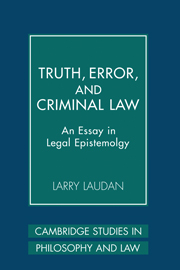Book contents
- Frontmatter
- Contents
- Preface
- Abbreviations and Acronyms Used
- 1 Thinking about Error in the Law
- PART I THE DISTRIBUTION OF ERROR
- 2 The Unraveling of Reasonable Doubt
- 3 Fixing the Standard of Proof
- 4 Innocence, the Burden of Proof, and the Puzzle of Affirmative Defenses
- PART II FLAWED RULES OF EVIDENCE AND PROCEDURE
- Index
4 - Innocence, the Burden of Proof, and the Puzzle of Affirmative Defenses
Published online by Cambridge University Press: 05 June 2012
- Frontmatter
- Contents
- Preface
- Abbreviations and Acronyms Used
- 1 Thinking about Error in the Law
- PART I THE DISTRIBUTION OF ERROR
- 2 The Unraveling of Reasonable Doubt
- 3 Fixing the Standard of Proof
- 4 Innocence, the Burden of Proof, and the Puzzle of Affirmative Defenses
- PART II FLAWED RULES OF EVIDENCE AND PROCEDURE
- Index
Summary
In all cases of penal procedure, the declared supposition is, that the party accused is innocent; and for this supposition, mighty is the laud bestowed upon one another by judges and law-writers. This supposition is at once contrary to fact, and belied by their own practice…. The defendant is not in fact treated as if he were innocent, and it would be absurd to deal by him as if he were. The state he is in is a dubious one, betwixt non-delinquency and delinquency: supposing him non-delinquent, the[n] immediately should that procedure against him drop; everything that follows is oppression and injustice.
– Jeremy Bentham (1829)If the presumption of innocence is not sacred in our system then what is to become of us?
– Judge Reta Strubhar (Oklahoma Court of Criminal Appeals)In the last two chapters, we have looked at the SoP and the BoD. It is time to turn our attention to the other two principal ingredients of what I have been calling error distribution doctrine: the burden of proof and the presumption of innocence. On their face, these might seem to be comparatively simple matters. Basically, the thesis of the burden of proof says that the defendant need prove nothing, while the state carries the full obligation to establish the guilt of the accused to the appropriate standard of proof. The presumption of innocence instructs jurors that they are to suppose the defendant innocent until and unless the prosecutor has discharged that burden.
- Type
- Chapter
- Information
- Truth, Error, and Criminal LawAn Essay in Legal Epistemology, pp. 89 - 114Publisher: Cambridge University PressPrint publication year: 2006



